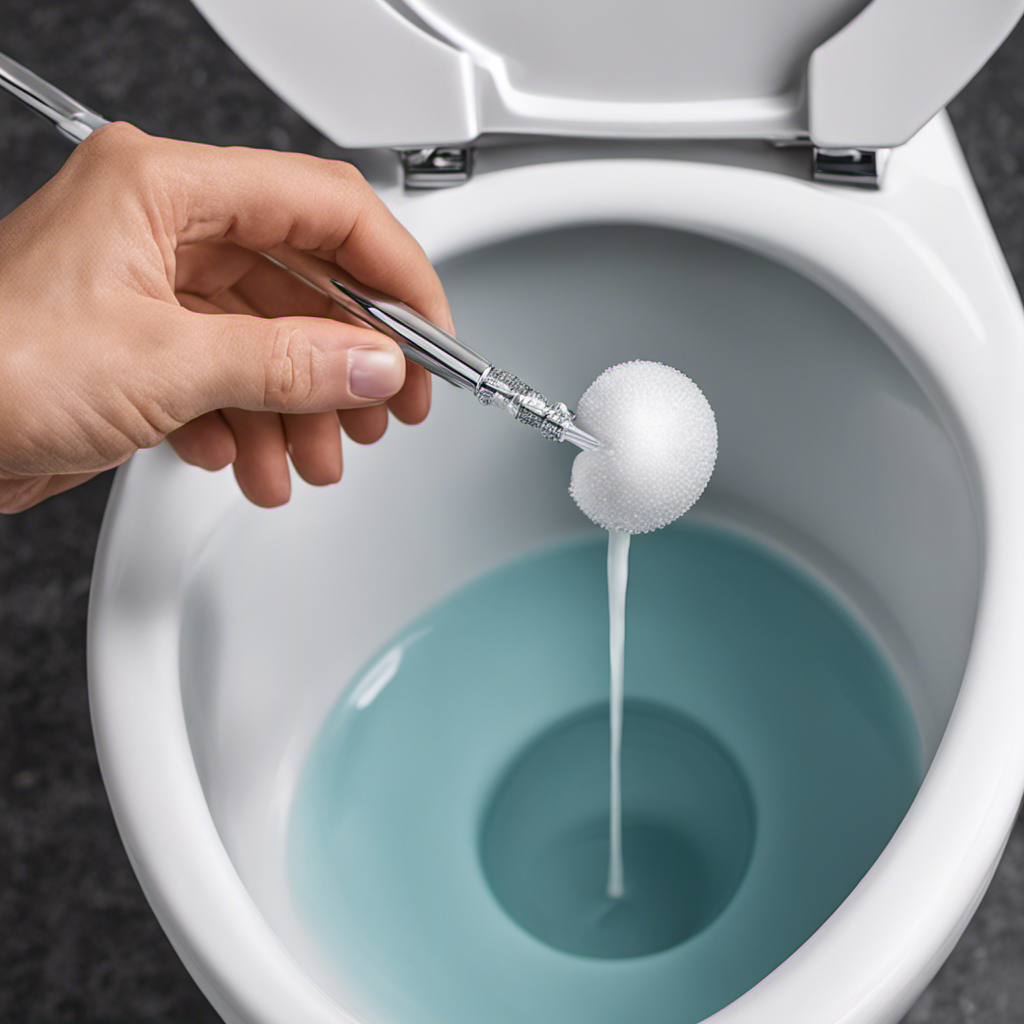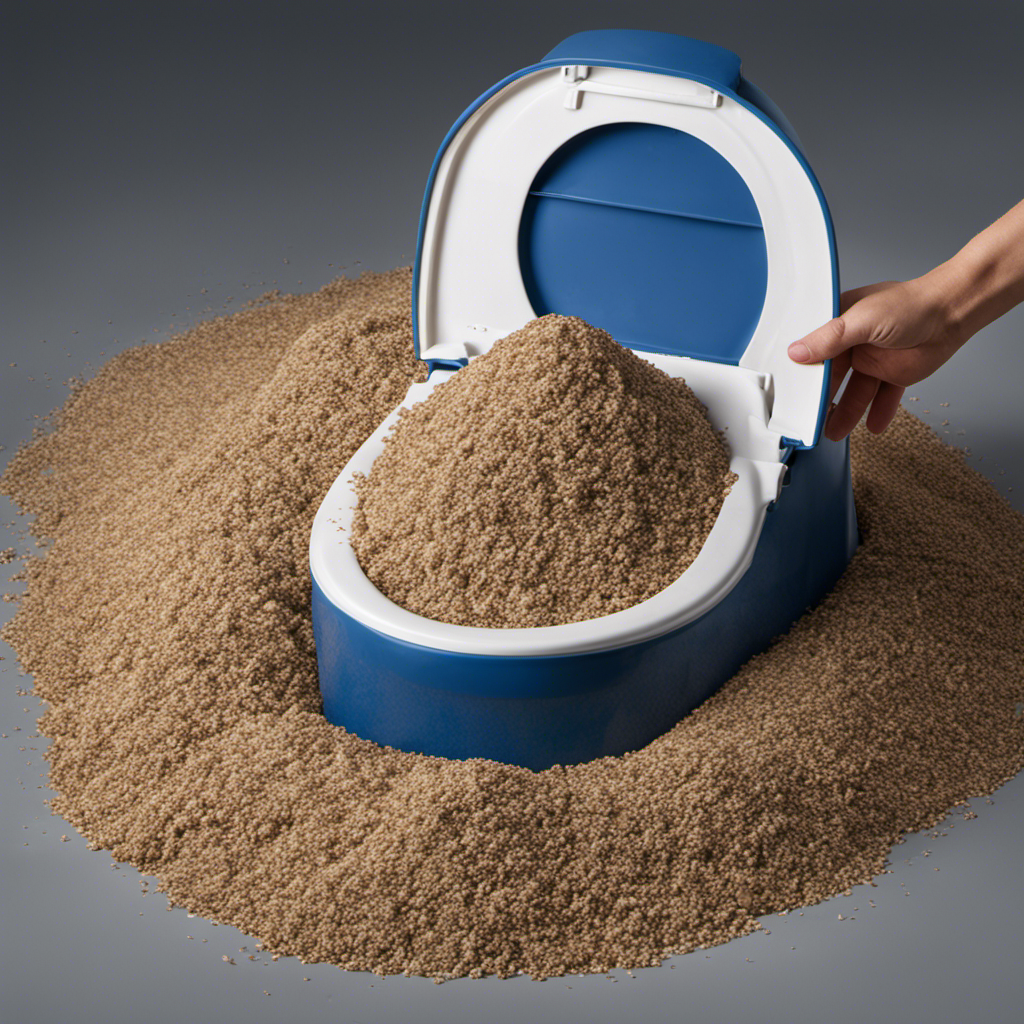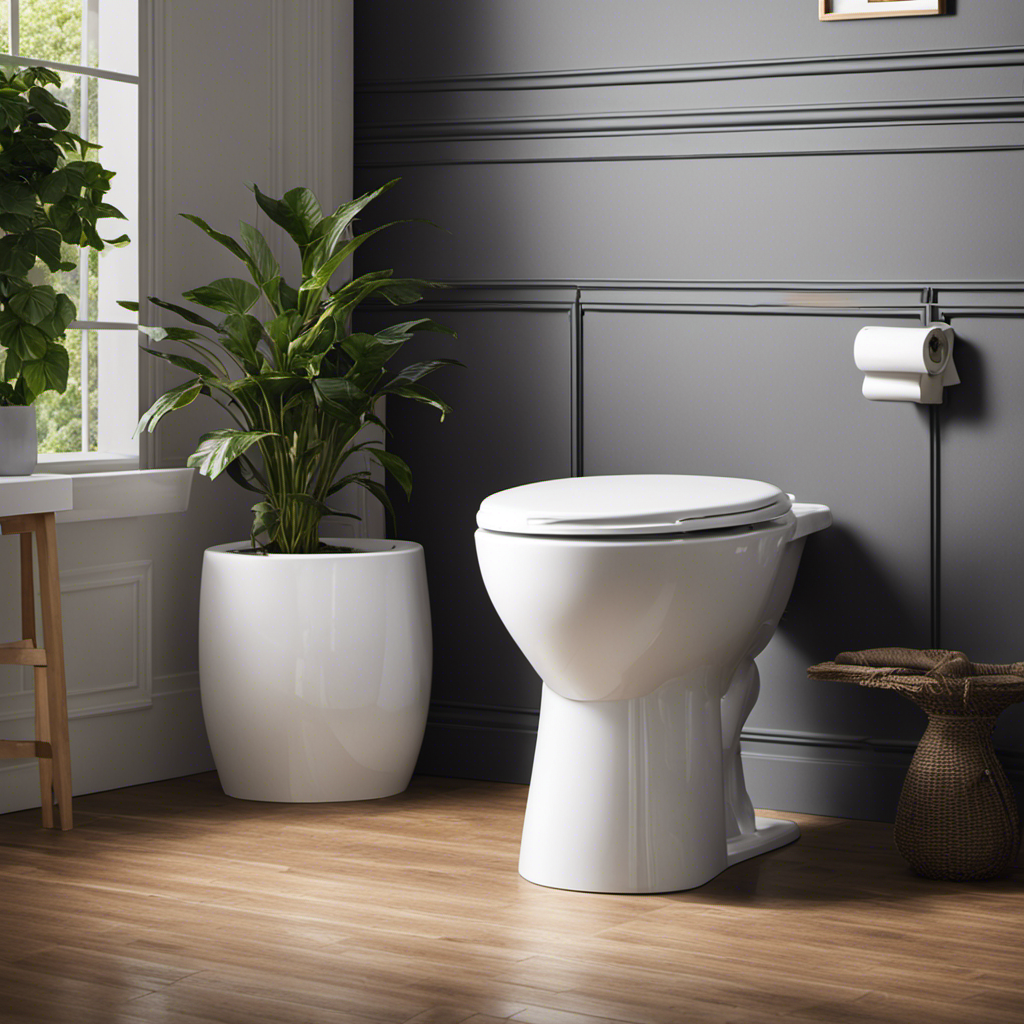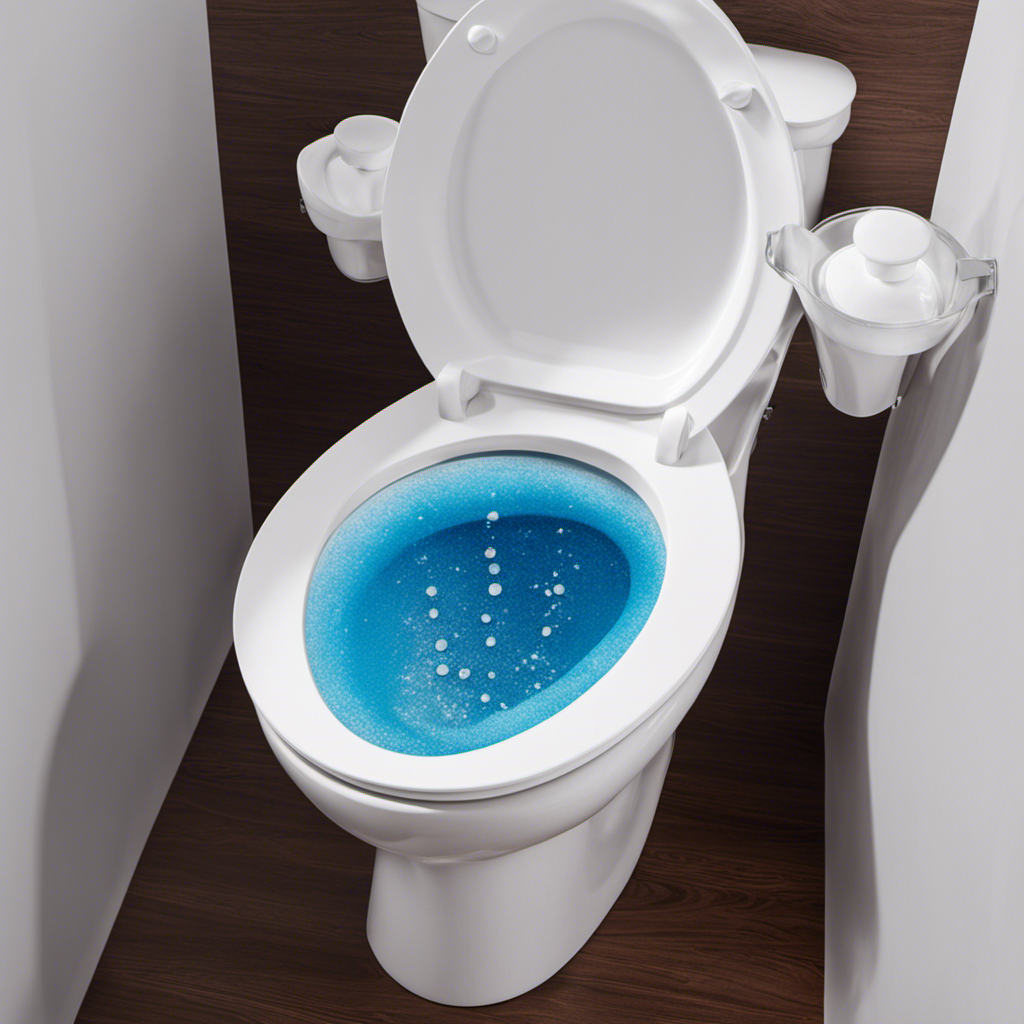I’ve got some good news and some bad news: the bad news is that a flushed Clorox toilet wand head can cause some serious issues in your toilet.
The good news is that I’ve got five effective solutions to help you remove it. Trust me, you don’t want to deal with clogs, obstructed water flow, or drain blockages.
Chemical cleaners won’t do the trick, so it’s time for some manual removal.
Let’s dive into these solutions and get your toilet back in working order.
Key Takeaways
- Flushing Clorox toilet wands can cause clogs, obstruct water flow, and disable the sewer line.
- The fibers of the wand are waterproof and resistant to flushing, leading to waste balls and drain blockages.
- Chemical cleaners are ineffective, so manual removal is necessary.
- Solutions for removing the flushed wand head include using hands with waterproof gloves, grabbing it with a coat hanger, using a toilet auger, or creating a vacuum force with a plunger or wet/dry vacuum cleaner.
Solution 1: Manual Removal With Rubber Gloves
I can remove the flushed Clorox toilet wand head manually by using rubber gloves.
When it comes to using Clorox toilet wands, there are both pros and cons to consider. On the positive side, these wands provide a convenient and easy way to clean the toilet bowl. They come with disposable heads that can be easily replaced, eliminating the need for traditional toilet brushes.
However, one major drawback is the potential for clogs and drain blockages. The wand heads are not water-soluble and can collect particles, leading to the formation of waste balls that can obstruct the water flow.
To prevent this, it is important to avoid flushing the wand heads down the toilet. Instead, they should be manually removed using waterproof rubber gloves.
Solution 2: Using a Metal Coat Hanger
To grab the wand head from the toilet bowl using a metal coat hanger, create a hook at the end of a straightened hanger and insert it into the toilet.
Pros of using a metal coat hanger for toilet clog removal:
- Cost-effective solution: A metal coat hanger is a readily available and inexpensive tool for removing clogs.
- Versatile: The flexibility and shape of a metal coat hanger allow for easy maneuvering and reaching the clog.
- Effective for small clogs: A metal coat hanger can effectively dislodge small obstructions in the toilet drain.
Cons of using a metal coat hanger for toilet clog removal:
- Limited reach: The length of a metal coat hanger may not be sufficient to reach deep clogs or blockages.
- Risk of scratching: The metal wire of the hanger can potentially scratch the porcelain surface of the toilet bowl.
- Ineffective for stubborn clogs: A metal coat hanger may not be strong enough to break up or remove stubborn clogs.
Tips for preventing toilet clogs and drain blockages:
- Avoid flushing non-flushable items such as wipes, sanitary products, and dental floss.
- Use toilet paper in moderation to prevent excessive buildup in the drains.
- Regularly clean and maintain the toilet to prevent the accumulation of debris and mineral deposits.
Solution 3: Extracting With a Toilet Auger
Using a toilet auger is an effective method for extracting the wand head from the toilet bowl. When using a toilet auger, it is important to take certain safety precautions.
First, ensure that the toilet is filled with two gallons of water to provide lubrication and prevent damage to the drains.
Second, wear rubber gloves to protect your hands from any potential contaminants. Rubber gloves offer several benefits during toilet wand removal. They provide a barrier between your skin and the wand head, minimizing the risk of direct contact with any dirt or bacteria. Additionally, the gloves offer a better grip, allowing you to firmly grasp and extract the wand head without slipping.
Solution 4: Using a Plunger
When attempting to remove the wand head from the toilet bowl, it is important to choose the right plunger and apply enough force to create a vacuum strong enough to pull it out. Using a plunger can be an effective solution for unclogging toilets, but it also has its pros and cons.
Pros of using a plunger for toilet clogs:
- It is a simple and affordable tool that can be easily found in most households.
- Plungers can create a strong suction force, which can help dislodge the clog and restore proper water flow.
- It is a safe and chemical-free method that does not damage the toilet or the plumbing system.
Cons of using a plunger for toilet clogs:
- Plungers may not always be effective for severe or stubborn clogs.
- It requires physical effort and can be messy if not done properly.
- If not used correctly, plunging too forcefully can cause water to splash out of the toilet bowl.
Tips for preventing clogs in the toilet:
- Avoid flushing non-flushable items such as wipes, sanitary products, or toys.
- Use toilet paper sparingly and flush in small amounts to prevent overwhelming the system.
- Regularly clean the toilet bowl and remove any visible debris to prevent blockages.
Solution 5: Using a Wet/Dry Vacuum Cleaner
I found that using a wet/dry vacuum cleaner was an effective solution for extracting the wand head from the toilet bowl. This method allows for easy and efficient removal without the need for additional tools or manual labor. The vacuum cleaner creates suction that can effectively pull out the wand head from the S-shaped trap of the toilet.
| Pros of Using a Wet/Dry Vacuum Cleaner | Cons of Using a Wet/Dry Vacuum Cleaner |
|---|---|
| Quick and efficient removal | Requires a wet/dry vacuum cleaner |
| No need for additional tools | Higher cost compared to other methods |
| Minimizes physical contact with waste | Limited reach for deep toilet bowls |
When considering alternative methods for retrieving flushed objects from toilets without using any tools, it is important to weigh the pros and cons. Using chemical cleaners may seem like a convenient option, but it has its drawbacks. These cleaners can be harsh on the toilet’s plumbing and may not effectively remove the object. Additionally, they introduce chemicals into the water system, which can be harmful to the environment. Alternatively, manual methods like using gloves or a coat hanger can be effective, but they require physical contact with waste. Ultimately, the choice of method depends on the individual’s preferences and resources available.
Step-By-Step Instructions for Solution 1: Manual Removal With Rubber Gloves
To extract the wand head manually, I first put on waterproof rubber gloves as a protective measure. Here are the step-by-step instructions for Solution 1: Manual Removal with Rubber Gloves:
-
Scrub the toilet bowl using a wipe before removing the wand head. This ensures cleanliness and minimizes any potential mess.
-
If you prefer not to use your hands directly, use a plastic cup and a sponge to empty the bowl before proceeding.
-
Push your fingers as deeply as possible into the toilet bowl outlet, and pinch the wand head firmly to remove it. Be careful not to drop it back into the bowl.
-
After successfully removing the wand head, flush the toilet a couple of times to refill the bowl and ensure proper functioning.
Pros and Cons of Using Clorox Toilet Wand:
Pros: Convenient, easy to use, kills germs effectively.
Cons: Costly, produces waste with disposable heads, potential for accidents if flushed.
How to Prevent Flushing Clorox Toilet Wand Accidents:
Always dispose of the wand heads in a trash bin, never flush them down the toilet.
Step-By-Step Instructions for Solution 2: Using a Metal Coat Hanger
Using a long metal wire with a hook at the end, I grab the wand head from the toilet bowl outlet. This method, known as Solution 2, offers an alternative to manual removal with rubber gloves. Let’s examine the pros and cons of using a metal coat hanger for this task.
| Pros | Cons |
|---|---|
| Affordable and readily available | Requires some dexterity and patience |
| Effective in catching the wand head | May scratch or damage the toilet bowl |
| Can be reused for other purposes | May not work if the wand head is lodged deep in the pipes |
| Allows for easy maneuverability | May require multiple attempts |
While using a metal coat hanger as an alternative method for removing a flushed Clorox toilet wand head has its benefits, it also comes with its limitations. It is important to consider the pros and cons before attempting this method.
Step-By-Step Instructions for Solution 3: Extracting With a Toilet Auger
When removing the wand head from the toilet bowl outlet, it is important to exercise caution and use a toilet auger. Here are three steps to safely extract the wand head using a toilet auger:
-
Prepare the toilet: Put on rubber gloves and fill the toilet bowl with two gallons of water. This will provide lubrication and prevent splashing during the extraction process.
-
Insert and rotate the auger: Carefully insert the toilet auger into the toilet, ensuring that the rubber handle is securely in your hand. Rotate the auger gently, being cautious not to damage the drains, especially if they are made of PVC pipes.
-
Pull out the wand head: Once the auger catches the wand head, start pulling it out slowly and steadily. Take care not to rush or force the extraction, as this can cause further damage.
Remember to flush the toilet a couple of times afterward to ensure proper functioning.
Toilet augers offer a safe and effective method for removing stuck objects like a flushed wand head.
Step-By-Step Instructions for Solution 4: Using a Plunger
In our previous discussion, we explored the step-by-step instructions for using a toilet auger to extract a flushed Clorox toilet wand head. Now, let’s move on to the next solution: using a plunger.
When it comes to unclogging toilets, a plunger is often the go-to tool for many people. It creates a vacuum force that can dislodge the obstruction and restore the normal flow of water. However, if you don’t have a plunger or prefer alternative methods, there are other options to consider.
Discussion ideas:
- Alternative methods for unclogging toilets without using a plunger.
- The importance of regular maintenance to prevent toilet clogs and blockages.
To further explore these ideas, let’s take a look at the following table:
| Alternative Methods for Unclogging Toilets | Importance of Regular Maintenance |
|---|---|
| Hot water and dish soap | Regular inspection of toilet flush mechanism |
| Baking soda and vinegar | Proper disposal of sanitary products |
| Enzyme-based drain cleaners | Avoiding excessive toilet paper usage |
| Manual extraction with a wire or coat hanger | Periodic professional plumbing check-ups |
Frequently Asked Questions
Can I Use Any Type of Gloves for Manual Removal With Rubber Gloves?
No, it is not recommended to use any type of gloves other than waterproof rubber gloves for manual removal. Alternative methods for removing the wand head include using a metal coat hanger or a toilet auger.
Is It Safe to Use a Metal Coat Hanger in the Toilet Bowl?
Yes, using a metal coat hanger in the toilet bowl can be safe if done properly. However, there are alternative methods like using a toilet auger or a plunger, which are considered best practices for toilet wand head removal.
How Much Water Should I Fill the Toilet Bowl With Before Using a Toilet Auger?
To use a toilet auger effectively, fill the toilet bowl with about two gallons of water. This water level helps the auger to create the necessary pressure and friction to dislodge the wand head.
Are There Any Specific Precautions I Should Take When Using a Plunger to Remove the Wand Head?
When using a plunger to remove the wand head, it’s important to take precautions. Wear rubber gloves for removal and ensure a tight seal between the plunger and the toilet bowl to maximize suction.
Can a Wet/Dry Vacuum Cleaner Damage the Toilet or Plumbing System?
Using a wet/dry vacuum cleaner to remove a flushed Clorox toilet wand head may damage the toilet or plumbing system. It’s best to consider alternatives like manual removal methods to avoid potential risks.
Conclusion
Well, folks, we’ve reached the end of our informative journey on how to deal with a flushed Clorox toilet wand head.
After exploring the various solutions, it’s clear that this is no ordinary bathroom mishap. With the potential for clogs, blocked drains, and obstructed water flow, it’s a situation that requires immediate attention.
Thankfully, we’ve provided five solutions that are as precise as surgical procedures. From the manual removal with rubber gloves to the use of a wet/dry vacuum cleaner, we’ve covered it all.
So, next time you find yourself in this unfortunate predicament, remember these techniques and bid adieu to that stubborn wand head. Happy flushing, everyone!










